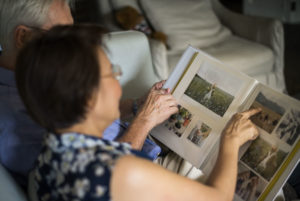
Pictures and photography have a powerful meaning in our lives. Whether it’s a grainy black and white Polaroid of a passed-on family story, a poignant professional shot of an occurrence across the world, or an amateur cell phone image of a baby’s first haircut—photos allow us to stop time, relive a moment, and evoke specific memories and feelings.
May is National Photo Month, which was initially established to celebrate the art and hobby of photography. However, we’re using this holiday to spotlight another important aspect of pictures and photography—memory stimulation in those with Alzheimer’s and related dementias.
With dedicated memory care communities throughout the San Antonio, Texas, area, Franklin Park® Senior Living is well-versed in innovative and nontraditional approaches to memory care. We’re taking a look at how using pictures can help those living with memory impairments through a process called reminiscent therapy.
Understanding the Connection
Even though people living with dementia and other memory impairments often struggle with short-term memory, they can usually recall events from the past, sometimes with vivid detail.
Looking at old pictures can help elicit memories, feelings, and even senses. This act of reminiscing can help evoke positive memories and calming feelings and can even reduce feelings of stress and agitation. Looking at old photos can also have other benefits, such as reducing isolation, starting meaningful conversations, and even improving cognitive abilities.
How to Use Photos to Stimulate Memory
Use the following tips for using photography in memory care and how to incorporate reminiscence therapy into your family member’s routine.
Make a “My Story” Photo Album
Creating a life story is a common and meaningful element in memory care. These stories can be incorporated into books, collages, digital apps, or shadow boxes. They can be as simple or complex as you want; the purpose is the content, not the format.
Life stories can help those with dementia preserve their past, relive important or fond moments, and help rediscover their sense of identity and belonging. They are also a great tool in giving caregivers and memory care staff a better understanding of who a person is and how best to communicate and engage with them.
To make a life story photo book:
- Start with photographs of your family member at all stages of their life.
- Include important events such as birthdays, milestone events like graduations and anniversaries, and other positive memories.
- Be conscientious while choosing photos, and avoid any that may evoke an unpleasant memory or negative feelings.
Tips on Choosing Photos and Designing Your Book
When choosing photos, make sure each image is clear, and people are easily recognizable. Try to keep pages simple and straightforward and avoid unnecessary colors and decorations that may confuse your family member. Label each photo with the date, events, and people included in clear writing. You can even buy a guided book or use a template to keep things easy and simple.
1. Show Relationships
In whatever format you choose, have a dedicated page or section showing the relationship between your family member and other important people in their life. Add labeled photos in chronological order that captures the unique bond over time. Doing this can help spark recognition of specific family members and be a meaningful activity for each person to share with your family member.
2. Start Conversations
Sometimes, looking at pictures of times gone by will naturally bring out conversations and stories. Your family member may see a photo and start sharing with you the background behind it. If they need some encouragement, ask them open-ended questions that may bring out some memories. Questions you can ask include:
- “This looks like a fun day. How were you feeling here?”
- “Tell me more about the people in this picture.”
- “What are some memories you have of this childhood home?”
- “What was your wedding like?”
Avoid asking specific questions like, “What was the name of this classmate?” or “When did you go on this vacation?”. Your family member may not know the answers to questions like these, and it could make them feel embarrassed or angry. Instead, ask general questions or wait for them to share stories in their own time and volition.
3. Come Back Frequently
As with many things, repetition is key when it comes to photo books and life stories. Once you have created your album or box, revisit it often with your loved one. Find out what time of day they are in the best mood and are most receptive to having discussions. If you share caregiving duties with a sibling or other family member, make sure they go through the photos with your older family member as well. If your parent lives in a memory care community, ask the staff to look at the pictures as regularly as they can.
Photos and Memory Care
Using photography to spark recognition and elicit memories is a powerful tool in memory care. By understanding why this is and learning ways to incorporate life stories and photo books into your family member’s routine, you can learn just how powerful photos can truly be.
Franklin Park® Senior Living offers dedicated Alzheimer’s and dementia care at resort-style communities throughout San Antonio. Our Refreshing Waters® Memory Care Program provides a combination of person-centered care and meaningful activities, including the use of photos and other mementos in shadow boxes.
To discover if our Refreshing Waters® Memory Care Program could benefit your family, reach out to our memory care team today.
